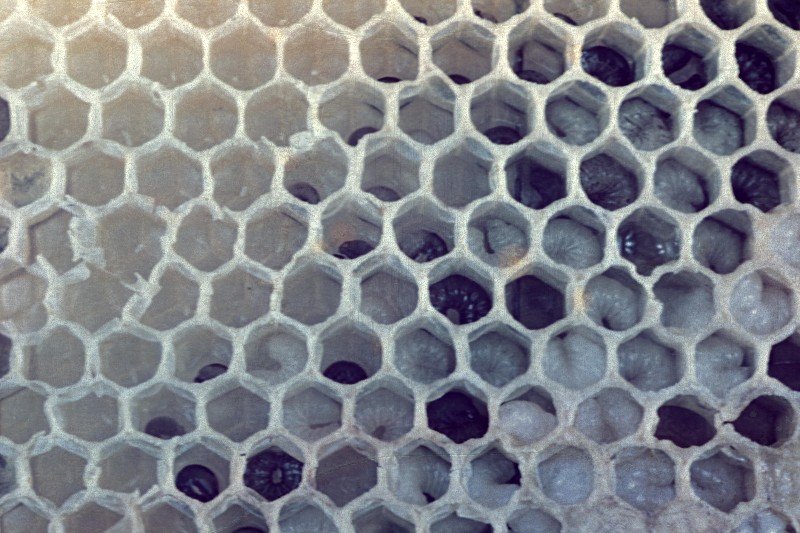Honeybee Diseases - Chilled Brood
Chilled Brood is a condition where relatively large areas of brood in all stages die at the same time and turn very dark in colour. Young larvae can survive for several hours at well below normal brood nest temperature (35℃) therefore the probable cause of this condition will be neglect by the adult and nurse bees in the colony. Death is due to a combination of prolonged exposure to cold temperatures and starvation. Examination of colonies in cold weather isn't generally recommended, but where necessary should not have this effect if carried out without swiftly, nurse bees will quickly return to tend and warm the brood.
Download the Chilled Brood Info Sheet to obtain a printable version of Chilled Brood information, detection and treatment methods for your records.
Recognition
Image Courtesy The Animal and Plant Health Agency (APHA), © Crown Copyright

Chilled Brood (dark in colour), the other brood has normal healthy colouring.
Relatively large areas of dead brood in the brood comb at all stages of development indicate a problem with adults tending the brood, be on the look out for other underlying problems.
Detection
Hive Examination - Examination of brood frames and floor debris is required especially in spring. Bees should be gently shaken from the frames to allow full inspection, abnormalities are then easily spotted.
Monitoring - Vigilance is important with all honeybee diseases. Check all apiaries and colonies regularly for health and suspect any colonies that are not thriving where there is no already known reason. Colonies that are not performing well or die out should be examined thoroughly and sealed to prevent robbing and spread of any disease present..
Treatment
There is no specific treatment recommended for Chilled Brood. Prevention is the best method of controlling this condition by maintaining healthy, strong and vigorous colonies that display good hygienic traits. Always ensure there is enough available food for the colony during periods of bad weather. Good husbandry contributes greatly to overall colony behaviour and health, thereby avoiding the conditions in which Chilled Brood can occur. There is no medical treatment for Chilled Brood. Dead brood will be removed by bees from the cells as soon as the colony grows stronger and returns to normal. Disease prevention is best practice, maintain good apiary housekeeping:
- Always maintain strong and vigorous colonies that show good hygienic tendencies, re-queen from known healthy colonies.
- Always maintain a high level of hygiene in all your beekeeping practices
- Carry out methodical health inspections on a regular basis, checking for brood disease particularly in spring and autumn.
- Never transfer combs between colonies without checking for brood diseases
- Systematically replace old brood combs in your hives melting down the old comb to maintain clean and healthy brood.
- Never bring colonies or equipment into your apiary without establishing their origin, condition, and disease status.
- Sterilise any secondhand equipment or hive components before introducing them into your apiary
- Discourage drifting and robbing in the apiary
- Suspect stray swarm health until you know otherwise
- Report any incidence of disease or suspicious conditions immediately to your local association
Vectors
There are no vectors identified for this condition.
Try the Honeybee Diseases Quiz
About the 'My Beekeeping Kit' website.
Contact Iain Dewar for enquiries, suggestions, corrections and contributions for improving the notes. Always welcome!